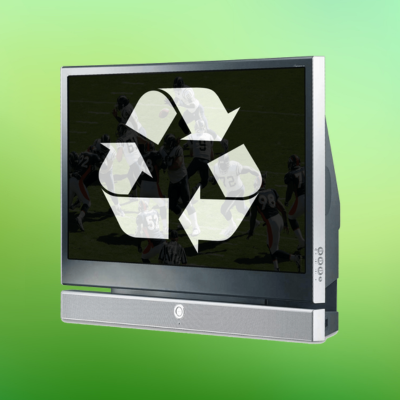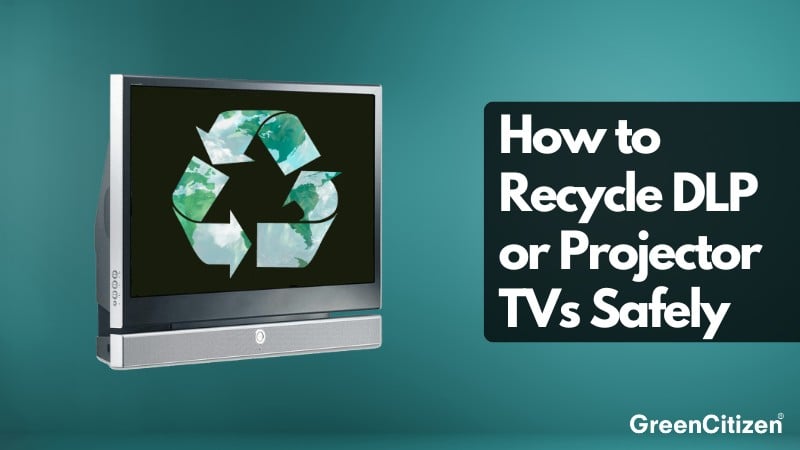If you still have a large DLP TV taking up space, don’t leave it on the curb — these units contain mercury lamps, circuit boards, glass lenses, and heavy plastics that must be handled by certified e-waste recyclers.
Proper DLP TV recycling keeps toxic materials out of landfills, recovers reusable components, and ensures compliance with state and federal e-waste regulations.
💡 Quick Answer: The right way to dispose of a DLP or projector TV is to bring it to a certified electronics recycler or authorized drop-off center that handles large televisions. This guarantees your old TV is recycled safely, legally, and in an environmentally responsible way.
Over the next sections, you’ll learn:
- What DLP TVs are and why they need special recycling
- Where to recycle DLP and projector TVs near you
- How GreenCitizen helps Bay Area residents and businesses recycle them responsibly
💡 Key Takeaway: How to Recycle a DLP or Projection TV
You can’t recycle DLP or projection TVs like regular electronics — they must go to a certified e-waste recycler that handles large televisions and mercury lamps. These TVs contain hazardous and valuable materials that require proper processing to stay out of landfills. Use recycling locators — like the Green Directory — to find certified recyclers near you.

Recycle Your DLP TV the Right Way
Recycle Your Bulky DLP TV with Ease — GreenCitizen Ensures Proper Handling Under California E-Waste Regulations.
What Is a DLP TV? Can You Recycle Them?
A DLP TV (Digital Light Processing TV) is a type of rear-projection television that uses millions of microscopic mirrors on a DLP chip to reflect light and create an image.
Instead of a flat LCD or plasma screen, a DLP TV projects the picture onto the back of the screen using an internal light source — typically a high-pressure lamp, LED, or laser.
💡 In short: DLP TVs are large, box-shaped projection TVs popular in the early 2000s for delivering big-screen images before flat panels became affordable.
Common Names and Brands of DLP or Projector TVs
Many DLP TVs were marketed under different names depending on the manufacturer. If you owned one of the following models, you likely had a DLP or similar projection-based TV:
| Brand | Marketing Name / Model Series | Technology |
|---|---|---|
| Samsung | DLP HDTV / LED DLP TV | DLP |
| Mitsubishi | Home Cinema DLP / LaserVue | DLP (Lamp or Laser) |
| Toshiba | Cinema Series DLP | DLP |
| Sony | Grand WEGA / SXRD | LCoS (similar projection type) |
| JVC | HD-ILA | LCoS (Digital Light Amplifier) |
| Hitachi | Ultravision Projection TV | LCD Projection |
| Panasonic | PT Series Rear Projection | LCD Projection |
These TVs are often also labeled as “Rear-Projection,” “Microdisplay,” or “Big-Screen” TVs on the back panel or in user manuals — a quick clue that you’re looking at a DLP-class device.
Can DLP or Projector TVs Be Recycled?
Yes — DLP TVs are recyclable, but due to their large size and mixed materials (plastic casing, glass screen, circuit boards, and sometimes mercury-containing lamps), they must be taken to a certified electronics recycler rather than disposed of curbside.
DLP and projection TVs are processed through certified electronics recyclers, where materials such as circuit boards, copper wiring, and plastics are separated for recovery, and any mercury-containing lamps are safely handled under California DTSC and SB20 e-waste standards to ensure safe disposal.
⚠️ Important: Do not disassemble a DLP TV at home — the lens and light engine are bulky and fragile. Improper handling can lead to injury or contamination from internal components such as mercury lamps.
How To Recycle a DLP TV or Projection TV
You can recycle a DLP TV by arranging a pickup or drop-off through a certified e-waste recycler that accepts large projection units.
Never place them curbside or in regular recycling bins.
DLP and other rear-projection TVs require special recycling because they contain a mix of plastics, glass, circuit boards, and sometimes mercury lamps. Unlike flat screens that fit standard e-waste programs, these large, box-style TVs need handling by facilities equipped to dismantle bulky electronics safely.
Step-by-Step: How Do You Recycle a DLP TV Properly?
Step 1: Confirm it’s a DLP or projection model.
Look for terms like “DLP,” “SXRD,” “HD-ILA,” “Rear Projection,” or “Microdisplay” on the back label or in the manual. Knowing the type helps recyclers anticipate lamp or component hazards.
Step 2: Check local e-waste regulations.
In some states (like California, Washington, or New York), projection TVs fall under Covered Electronic Waste (CEW) programs, meaning they can only go to approved drop-off sites. Check your city or county waste authority before moving it.
Step 3: Find a certified recycler that handles large TVs.
Search for R2 or e-Stewards-certified recyclers in your area. Many standard e-waste events do not accept bulky TVs — you’ll need one that advertises “large display” or “projection TV” acceptance.
Step 4: Prepare the TV for safe transport.
- Keep it upright to avoid cracking the internal mirror.
- Use a dolly or two people for lifting; DLP sets often weigh 80–150 lbs.
- Tape doors or panels shut, and if it’s a lamp model, mark it “Contains mercury lamp.”
Step 5: Arrange pickup or drop-off.
- Some recyclers or haulers offer residential pickup for a small fee (typically $40–$75).
- Others may have free drop-off days at municipal transfer stations.
- Retailers like Best Buy may accept projection TVs up to certain sizes (usually ≤49″). Always confirm in advance.
⚠️ Do’s and Don’ts for Recycling DLP TVs
✅ Do’s
❌ Don’ts
- Verify that your recycler is certified (R2, e-Stewards)
- Transport upright and secured
- Don’t disassemble the TV — lamps and lenses are hazardous
- Don’t leave it on the curb or toss in dumpsters
- Don’t try to extract parts (like Fresnel lenses) for resale
- Don’t mix projection TVs with normal electronics recycling
💡 TL;DR: You can’t recycle DLP TVs like normal appliances. Because they’re large, fragile, and often contain mercury lamps, they must go to certified e-waste recyclers equipped to process projection units.
Check local e-waste programs, schedule pickup or drop-off, and keep the unit intact — that’s the safest, legal, and environmentally responsible way to recycle a DLP TV.
Where To Recycle a DLP or Projection TV Near Your Location
If you still have a bulky DLP TV, the right way to recycle it is through programs that handle large electronics safely — never through regular trash or curbside pickup.
Below are the most reliable options across the United States:
4 Ways to Recycle a DLP TV
1. Certified E-Waste Recyclers (Best Option)
Find an R2 or e-Stewards-certified recycler near you. These companies are equipped to handle hazardous components like mercury lamps, lead solder, and heavy glass lenses.
- Use the Green Directory to find trusted electronics recyclers near you — it lists verified collection sites, mail-in options, and pickup services nationwide.
- Many local recyclers offer pickup services for oversized TVs.
- Examples:
- GreenCitizen (San Francisco Bay Area)
- Cohen Recycling (Midwest/Chicago)
- Lower East Side Ecology Center (New York City)
2. Municipal or County E-Waste Drop-Off Programs
Your city or county waste authority may have designated electronics collection events or permanent e-waste drop-off facilities. It can be a good and easy solution for disposing of DLP TVs.
- Check your local government’s website under “Household Hazardous Waste” or “Electronics Recycling.”
- Larger counties (e.g., Los Angeles, Cook, King, Alameda) have year-round programs that accept projection TVs.
- Always confirm acceptance and any item-size restrictions before loading your TV.
3. Retailer Recycling Programs
Some major electronics retailers offer in-store recycling or haul-away options for DLP or projector TVs. Still, it’s always best to ask the specific stores to know about the recycling policies.
- Best Buy: Accepts most TVs up to 50″ at stores; larger ones qualify for paid haul-away.
- Staples: Accepts smaller TVs and monitors depending on location.
- Office Depot/OfficeMax: Offers prepaid recycling boxes for smaller electronics.
Always call ahead — policies vary by state and store.
4. Manufacturer Take-Back Programs
Many TV brands sponsor end-of-life recycling partnerships:
- Sony, LG, Samsung, and Panasonic participate in MRM (Manufacturer Responsibility Management) programs that partner with local drop-off sites.
- Visit your manufacturer’s U.S. website → Support → Recycling or Take-Back Program to find participating locations.
- You don’t have to buy a new device to use these programs.
Summary: In the U.S., DLP TVs should be recycled through certified e-waste recyclers, municipal drop-offs, or retailer/manufacturer take-back programs. These ensure safe processing of hazardous materials like mercury and lead while recovering valuable metals and plastics responsibly.
How GreenCitizen Handles DLP TV Recycling
At GreenCitizen, we make DLP TV recycling simple and fully compliant for Bay Area residents and businesses. Whether you’re disposing of a single home projector TV or coordinating an office-wide equipment refresh, our process is built for convenience, transparency, and environmental responsibility.
Pickup and Drop-Off Services Across the Bay Area
We offer scheduled business pickups and residential drop-offs throughout the San Francisco Bay Area — including San Francisco, San Jose, Oakland, Palo Alto, Mountain View, and neighboring cities across the Peninsula, East Bay, and South Bay.
Our logistics team handles the heavy lifting — safely removing and transporting large projection TVs so you don’t have to move or load them yourself.
Full Accountability with GTAMS
Every DLP TV we collect is logged and tracked through our GreenCitizen Total Accountability Management System (GTAMS).
From pickup to processing, you’ll have a complete chain-of-custody record showing how each unit was handled and recycled. This provides peace of mind for residents and audit-ready documentation for businesses that require ESG, HIPAA, or SOC 2 reporting.
Certified, Local, and Responsible Recycling
We partner only with R2 and e-Stewards certified recyclers located in the U.S.
This ensures:
- No illegal export of hazardous materials overseas
- Proper handling of mercury lamps, glass lenses, and circuit boards
- All materials are recovered or recycled within certified domestic facilities
SB20 Compliance in California
Under California’s SB20 electronic waste law, GreenCitizen records the required information from each pickup or drop-off and submits data to approved partners for processing and reporting. This guarantees every DLP TV is recycled according to state and DTSC standards.

Recycle Your DLP TV the Right Way
Recycle Your Bulky DLP TV with Ease — GreenCitizen Ensures Proper Handling Under California E-Waste Regulations.
Conclusion: Responsible DLP TV Recycling Starts With the Right Partner
DLP and rear-projection TVs may be outdated, but they still contain valuable materials — and hazardous ones that should never reach landfills. Recycling them through certified programs ensures that glass, copper, and plastics are recovered safely while mercury and circuit boards are handled under strict environmental standards.
At GreenCitizen, we make that process simple for Bay Area residents and organizations. Whether you drop off a single unit or schedule a bulk pickup, every item is tracked, processed, and recycled responsibly under California’s SB20 and DTSC requirements.
